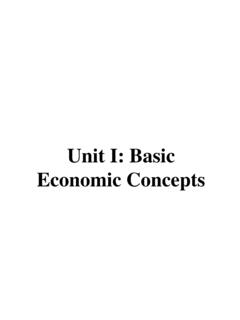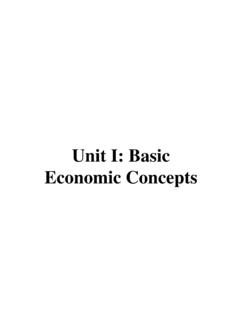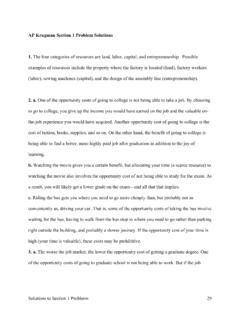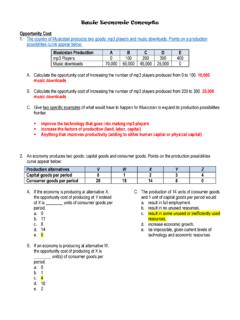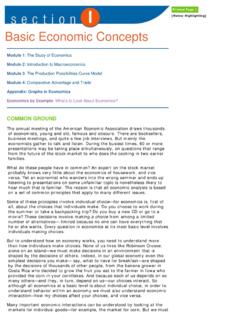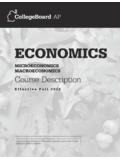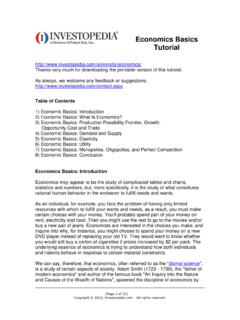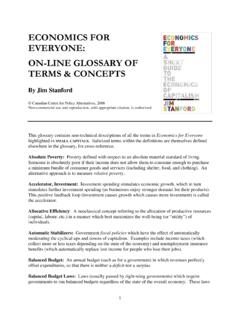Transcription of FBLA: ECONOMICS Competency: Basic Economic Concepts …
1 FBLA: ECONOMICS Page 1 competency : Basic Economic Concepts and principles tasks 1. Define money (characteristics, role, and forms) and trace how money and resources flow through the American Economic system. 2. Utilize decision-making models to make Economic choices and determine the opportunity cost of those choices. 3. Describe how trade-offs are made during the decision-making process. 4. Use Basic Economic Concepts (such as supply and demand; production, distribution, and consumption; labor, wages, and capital; inflation and deflation; market economy and command economy) to compare and contrast local, regional, and national ECONOMICS across time and at the present time.
2 5. Define the Basic elements of capitalism. 6. Explain how, in a free enterprise system, individuals attempt to maximize their profits based on their role in the economy. 7. Define characteristics of a market system ( , profit, competitive markets, and private ownership of property). 8. Compare and contrast Economic systems ( , traditional, market, command, and mixed) based on criteria such as freedom, efficiency, equity, security, employment, stability, and growth. 9. Analyze how Economic systems, resources, and culture affect each other.
3 10. Analyze how a nation s wealth and trade potential are tied to its resources. 11. Suggest what a nation or business should do if Economic resources are underutilized. 12. Identify the location of concentrations of selected natural resources and describe how their acquisition and distribution generates trade and shapes Economic patterns. 13. Analyze the Concepts of trade-offs and opportunity cost. 14. Evaluate the trade-offs of alternatives for solving societal problems according to Economic goals ( , Economic growth, equity, efficiency, security, employment, stability, and freedom).
4 15. Explain how the United States economy has changed from a rural to an industrial economy to a leader in the global economy. 16. Identify and explain various points of view concerning Economic issues, such as taxation, unemployment, inflation, the national debt and distribution of income. 17. Describe how personal decisions can have a global impact on issues such as trade agreements, recycling, and conserving the environment. 18. Recommend what a nation or business could do to stimulate Economic growth. 19. Define and explain Economic scarcity as it applies to production, consumption, and exchange.
5 20. Ascertain why scarcity faces people at all times and interpret the relationship between trade-offs and opportunity costs. 21. Explain why scarcity requires individuals, governments, and societies to make choices. 22. Analyze how scarcity creates the need for Economic policy and allocation. FBLA: ECONOMICS Page 2 competency : Productivity tasks 1. Define factors of production ( , labor, capital, entrepreneurship, and natural resources). 2. Explain the principle of diminishing returns and how it relates to productivity and consumption.
6 3. Describe how investments in human and physical capital, including new technology, affect standard of living, quality of life, and increase productivity. 4. Describe the impact of worker productivity (output per worker) on business, the worker, and the consumer. 5. Explain how wages are affected by the market value and productivity of the individual working. 6. Define specialization and identify how specialization may affect the economy. 7. Give examples to explain how businesses and industry depend upon workers with specialized skills to make production more efficient.
7 8. Discuss the effects of government expenditures, regulations, and tax policies on productivity. 9. Analyze the impact of political actions, natural phenomena ( , wars, legislation, and natural disaster), and the investments in research and development on producers and production decisions. 10. Analyze and discuss Economic indicators that reflect productivity. competency : Macroeconomics tasks 1. Differentiate between microeconomists and macroeconomists approach to the economy and their solutions to Economic problems.
8 2. Analyze factors that are studied in determining the Economic health of our economy. 3. Discuss how changes in disposable income affect the economy. 4. Explain the effects of leading Economic indicators on a personal financial plan. 5. Identify and analyze leading Economic indicators and the methods of using the indicators to validate opinions about the state of the economy in the near future. 6. Illustrate and measure the impact of inflation and recession. 7. Evaluate the impact of employment/unemployment on production, consumption, and exchange.
9 8. Define gross domestic product (GDP) and interpret fluctuations in the GDP. 9. Discuss major factors that affect the level of a country s gross domestic product (GDP) ( , quantity and quality of natural resources, quantity and quality of human capital, and quantity and quality of capital stock). 10. Locate the per capita GDP of various nations to compare the levels of Economic well-being. 11. Differentiate between GNP, NDP, NI, PI, and DI. 12. Explain how the Consumer Price Index measures the rate of inflation and interpret its relationship to purchasing power.
10 13. Interpret Economic data depicted through illustrations ( tables, curves, graphs, ratios, percentages, indexes, and values) 14. Construct tables and graphs depicting Economic information ( , financial statements, pie charts, line graphs, and bar graphs). FBLA: ECONOMICS Page 3 competency : Supply & Demand (Markets & Prices) tasks 1. Explain the law of supply, the law of demand, and equilibrium price. 2. Demonstrate an understanding of the supply and demand curves that show increases and decreases in quantity supplied and quantity demanded.

